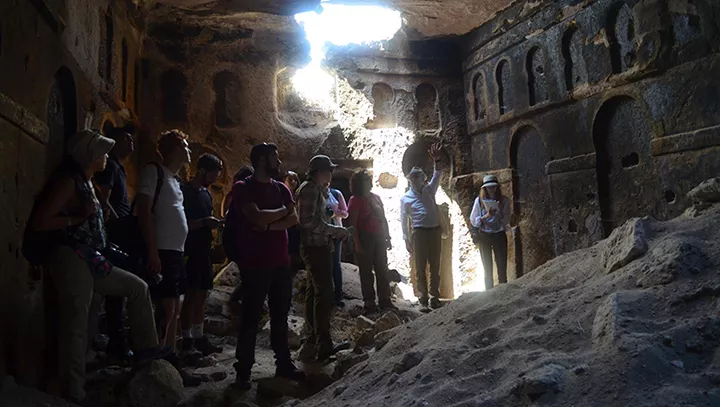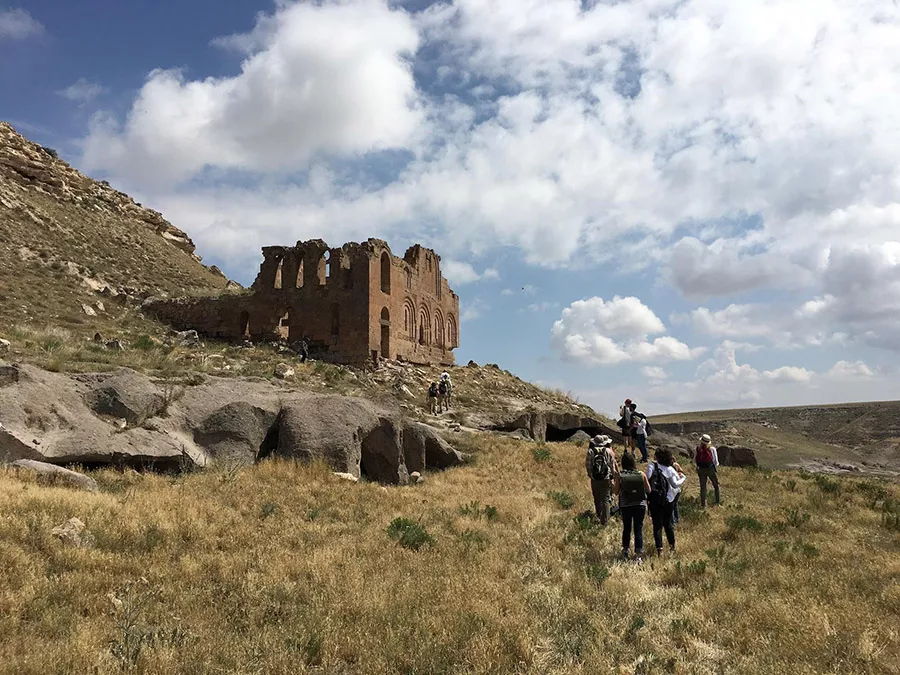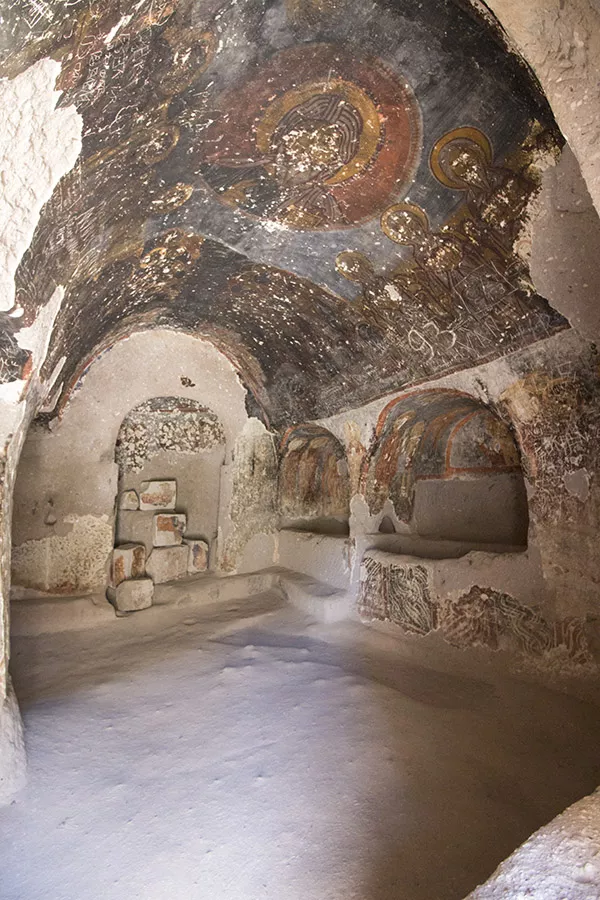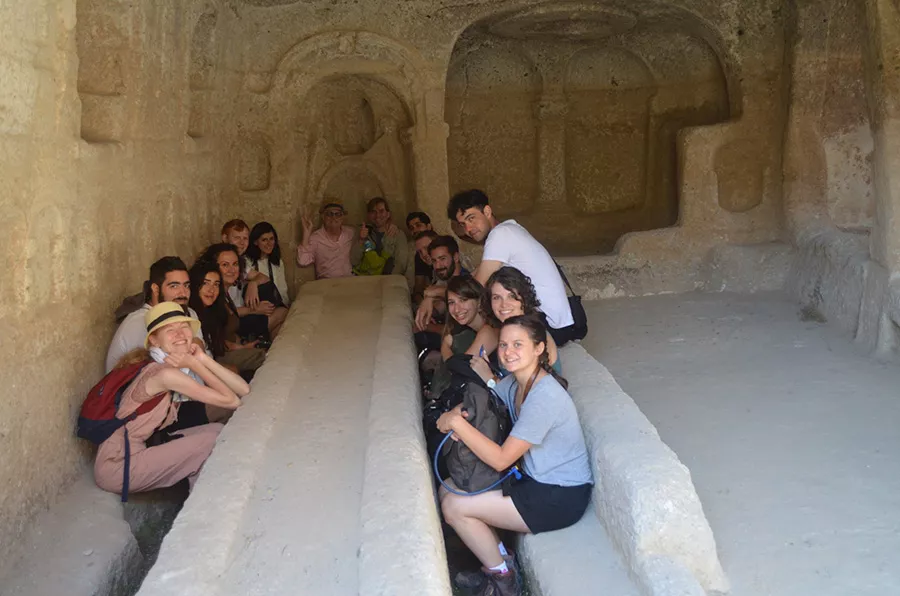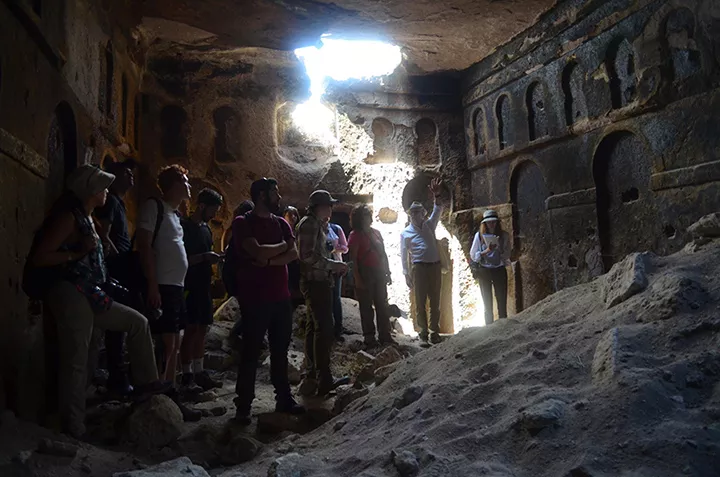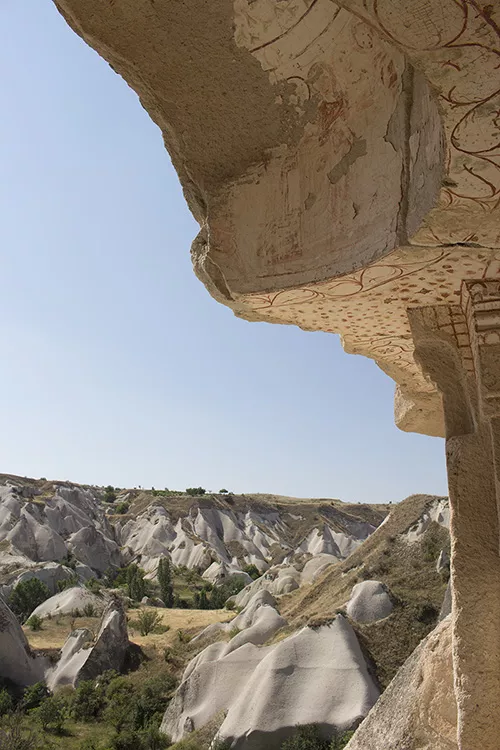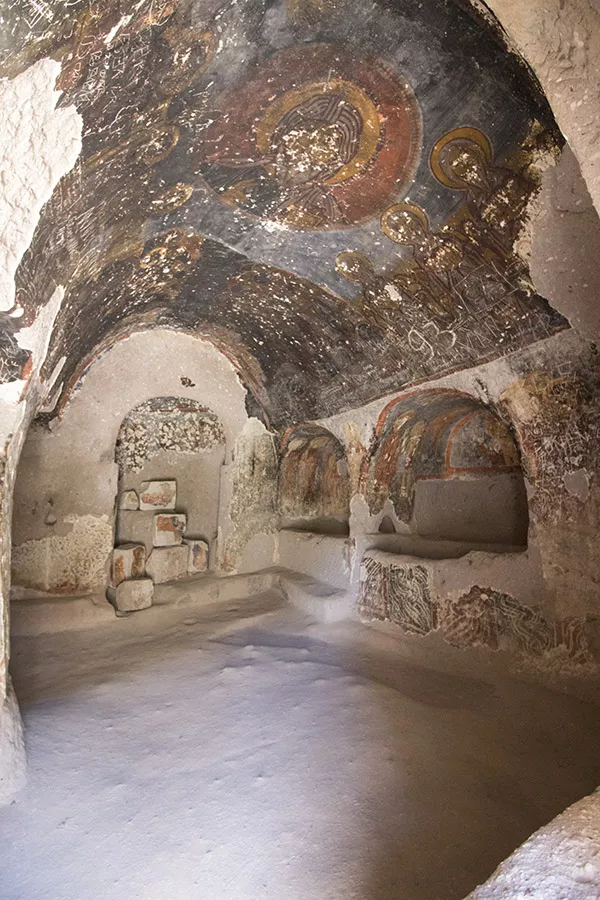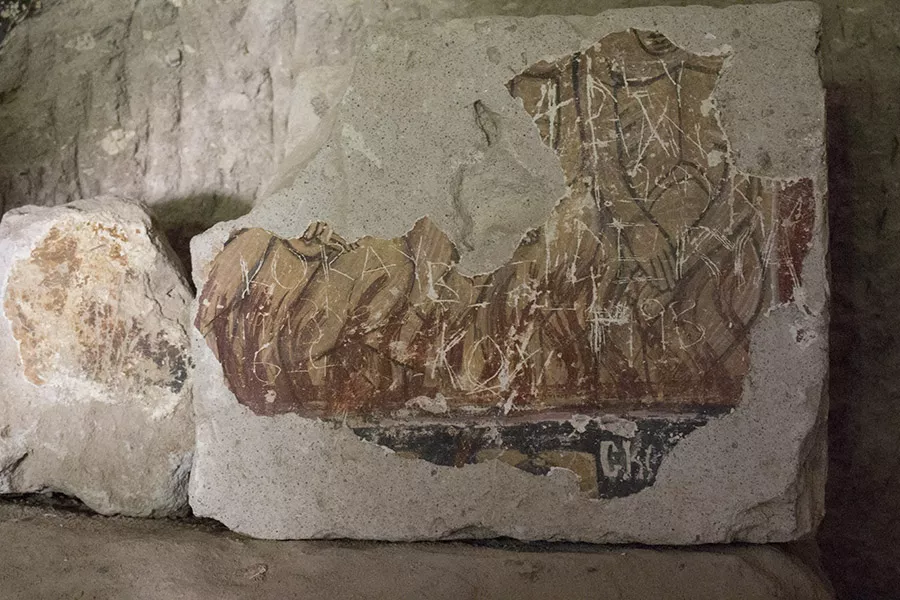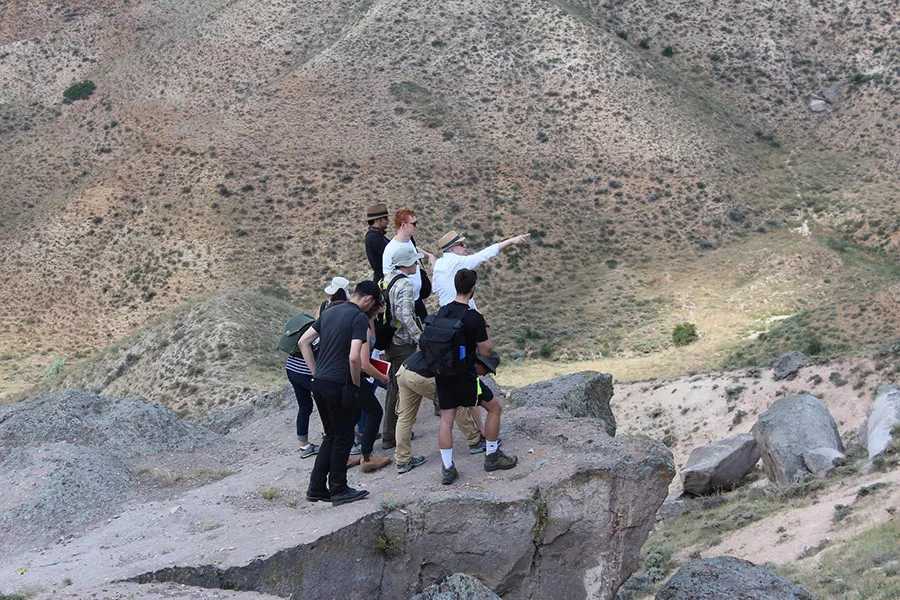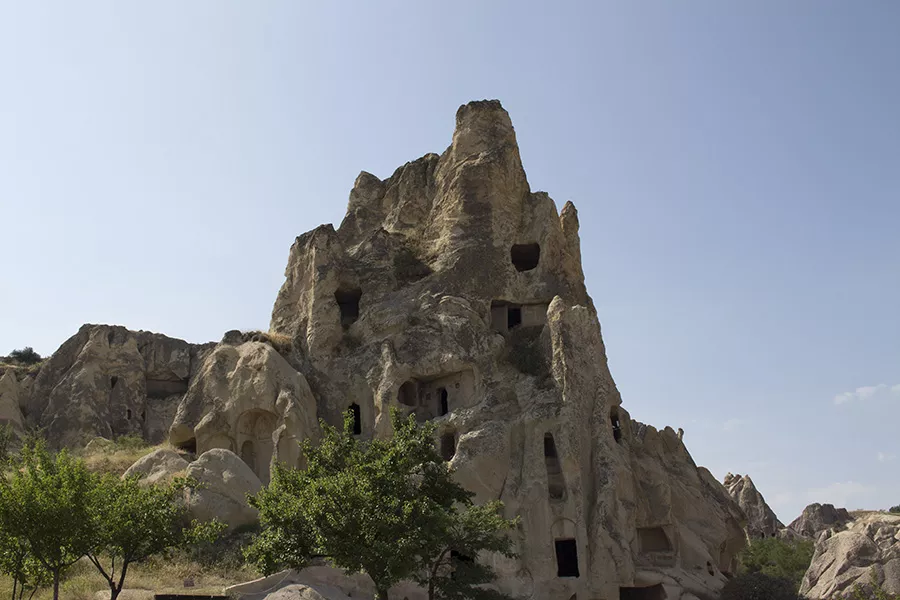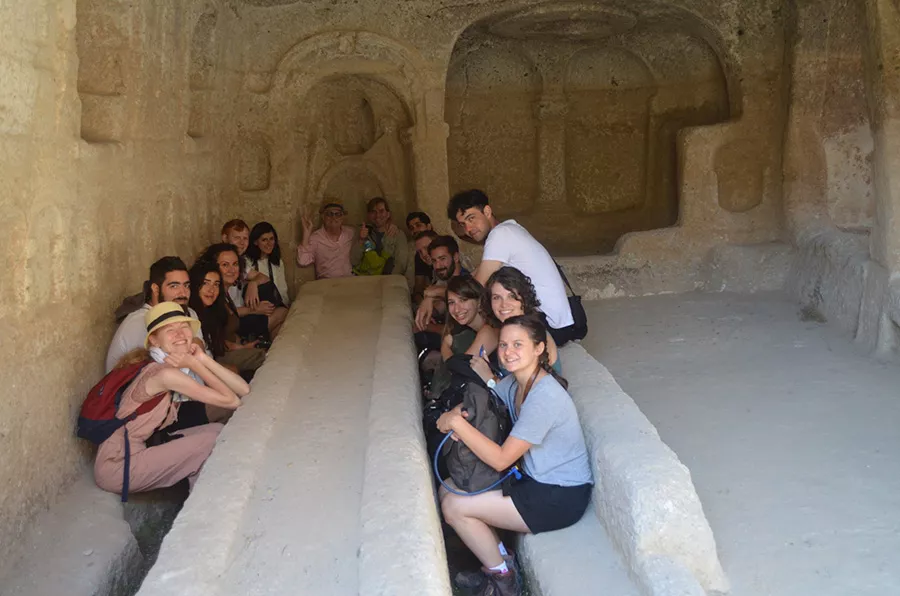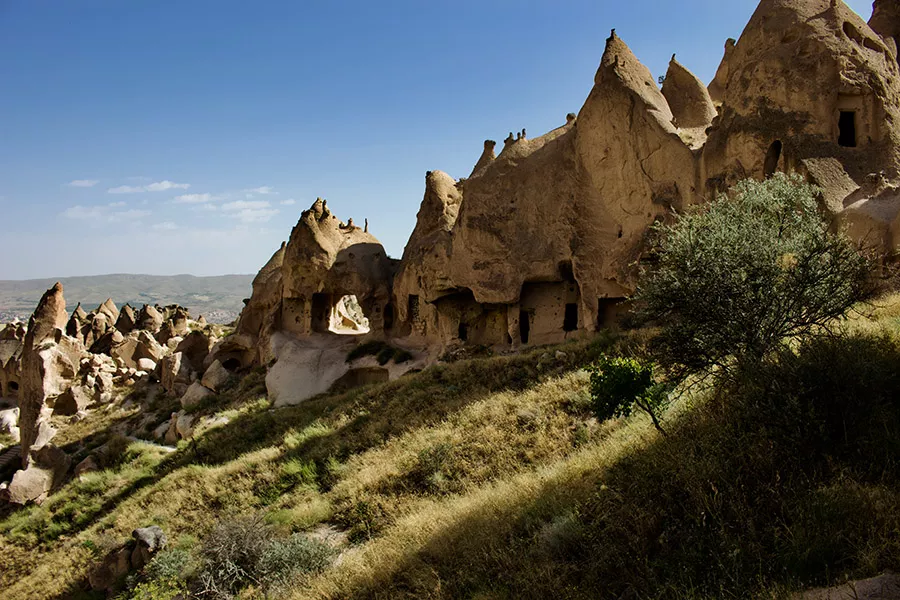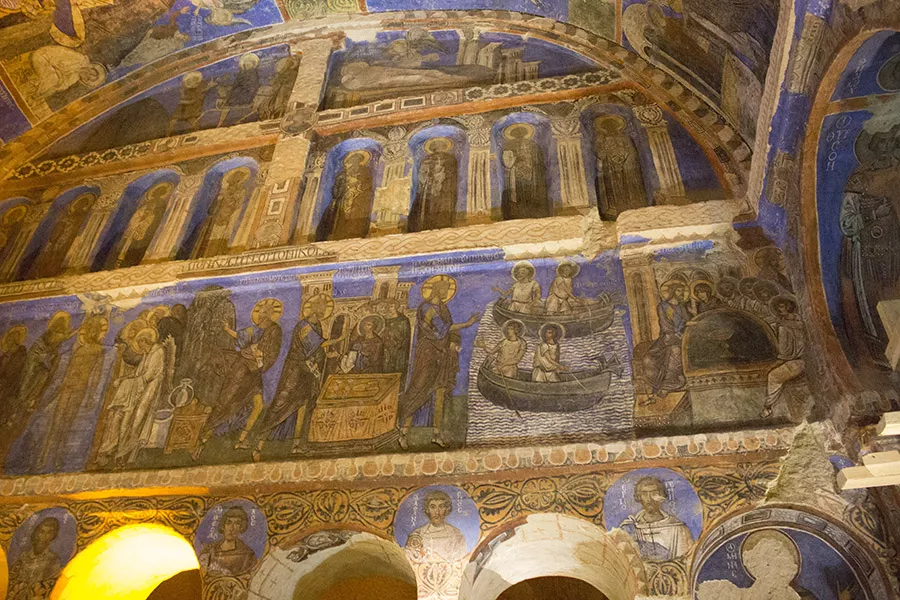Exploring Middle Byzantine Anatolia with Elena Gittleman (HART) and the Cappadocia in Context Summer Program
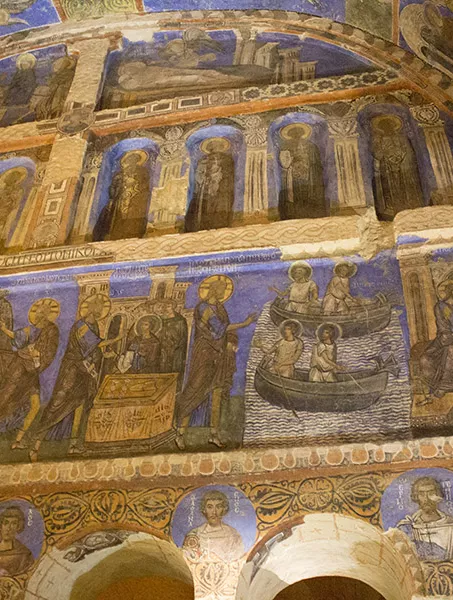
Deep in rural central Turkey, Medieval rock-hewn settlements lay nestled among a landscape of rugged steppe and hills as a monument to the region’s pre-Ottoman past. Hundreds of villages host over a thousand medieval churches that once formed the hinterland of the former Byzantine Empire (395-1453 C.E.) in the region of Cappadocia. Very little written history remains about this region in antiquity, but its archaeological preservation is staggering, providing crucial insights into a bygone era. From June 18th-July 3rd History of Art’s Elena Gittleman took part in the Cappadocia in Context summer program in Turkey to explore these fossilized rural Byzantine communities first hand. Each summer the program takes a select group of graduate students directly to over one hundred sites in two weeks to engage directly with the landscape, archaeology, and stunning visual culture of the region. Elena sat with us to talk about her experience, the Cappadocia in Context program, and the history and archaeology of Byzantine Cappadocia.
Elena’s research focuses on visual culture and archaeology of the Byzantine empire. Thus, joining Cappadocia in Context was an excellent supplement to her studies as she enters the next phase of her graduate research. Based around the city of Nevşehir, Elena and her cohort visited homes, churches, cemeteries, fortresses, and monasteries that were mostly cut directly into the region’s soft volcanic rock. As Elena describes it, each day was intensive with hikes up rugged terrain, lectures, group presentations, and surveys of Cappadocia’s rich church frescoes. Cappadocia in Context is run by ANAMED of the Koç University Research Center for Anatolian Civilizations. It is organized jointly by Professor Robert Ousterhout of the University of Pennsylvania and Dr. Tolga Uyar of Nevşehir Hacı Bektaş University. Elena joins a long-standing tradition of graduate students from Bryn Mawr’s Graduate Group in Archaeology, Classics, and History of Art attending the seminar.
Cappadocia in Context seeks to provide fresh insights into this often misunderstood region during the Middle Byzantine Period (9th c. – early 13th c. C.E.). For the breadth of the Byzantine period, Cappadocia was a reputable source of agricultural goods and military personnel, often referred to as the “Breadbasket of Byzantium.” It is also known as the birthplace of several notable 4th c. CE church Fathers. It was in Cappadocia that Basil the Great, his brother Gregory of Nyssa, and Gregory of Nazianzus were raised, who together shaped the theology of early Christianity in their definition of the doctrine of the Trinity. One of the main goals of the program is to afford junior Byzantinists the opportunity to reanalyze and contextualize firsthand Cappadocia’s many churches, situating them within a broader regional relationship with their contemporary communities. “What is frustrating about Cappadocia is that there is not very much written evidence with the exception of what is known about the early Church Fathers, and almost nothing from the Middle Byzantine Period, which is the period of most of the churches and settlements we visited,” noted Elena. Thus, recent scholars are heavily reliant upon a remarkably rich state of archaeological preservation to paint a portrait of Byzantine Cappadocia. Hundreds of settlements are extant, hosting over a thousand documented Byzantine churches, among which one third retain their original highly ornamental interior wall frescoes. Elena attributes this preservation to the remoteness of the region and general neglect when under Ottoman rule. While these factors might cause prolonged decay in other parts of the world, the dry, semi-arid conditions of central Turkey instead have worked in favor of the country’s archaeological heritage. However, a steady increase in tourism as well as earthquakes and weathering now threaten many sites.
The program therefore addresses the imbalance in prior scholarship by giving graduate students exclusive access to this Middle Byzantine landscape and generating a new wave of young scholars eager to clarify some of the most pertinent issues in Byzantine studies, such as giving a voice to these long overlooked rural communities. For Elena and the Cappadocia in Context group as a whole, the study of Cappadocia forms an important contrast to perspectives from the imperial center in Constantinople. “What we know of Cappadocia is the opposite of what is known from contemporary Constantinople, where the decorative programs no longer exist in extant churches because they had since been converted to mosques. We know from written sources that during the Middle Byzantine period there was a shift in the way churches were decorated, and there was an emphasis on hieratic motifs where different levels of saints would ascend the walls, with angels, archangels, Jesus, and Mary being depicted in their domes. While we don’t have the visual evidence for this in modern Istanbul, we do have exactly that in some of the churches in Cappadocia.” Even the architecture of Constantinople’s churches were interpreted in Cappadocia, presumably by itinerant artisans and architects. However, the rock-hewn construction technique in Cappadocia allowed architects there to create new forms that were impossible with masonry. Elena says, “that’s one of the coolest parts, they did try to mimic architecture from Constantinople, but they were able to do some weird things, such as add some extra domes, which would have never worked for free-standing architecture.”
Unlike the ruinous state of most archaeological sites, the architecture of some of these churches can still be experienced almost as they were in antiquity. One particular parish church at Canavar Kilise stood out for Elena, who describes an intersection of visual ornamental display and the space’s tectonics to draw the parishioner, and modern student, into a full-on sensory and numinous experience. She notes “it had these amazing images of heaven and hell, with two images of God the Father (a fairly rare image in Byzantine art) painted onto a monumental medallion on the church ceiling. The images of hell were painted onto the masonry narthex, which a parishioner would move through first. One would literally have to go through hell before entering the main room of the church – the heavenly space overseen by the image of God the Father – which was hewn from volcanic rock. For the parishioner, then, movement through the church metaphorically replicated an experience of salvation.”
The Cappadocia in Context program also instructed students on the various functional roles the church played for communities settled in the region, and how this aspect could be determined from the visual and archaeological remains. Some churches were funerary, whereas others were parish churches, an overlooked distinction in earlier Byzantine scholarship on rural Cappadocia. “In Byzantium you could not bury a person in a church that was used for the liturgy,” said Elena, “the difficulty, though, was that a lot of these sites were reused in later periods, so, there could have been an Islamic burial in some but because stratigraphic excavation had not taken place in these spaces (by earlier archaeologists), it made it difficult to associate some of these burials with funerary chapels. However, a lot of the funerary chapels had burials built in, under arches, called arcisolia, and were clearly part of the architectural strategy from the beginning. A lot of that evidence had been ignored in earlier scholarship and it was just assumed that the liturgy was performed in all of these churches. Now it is clear that some chapels were built specifically to bury important individuals and families within the community.”
Elena and her cohort also sought to engage more broadly with Cappadocia’s wider landscape. For a century the archaeology of Cappadocia has been defined by its historical relationship with early Christianity and the theological work of the Cappadocian Fathers. Thus, the region’s well-preserved settlements have long been assumed to be predominantly monastic communities. However, Elena notes that there is a staggering a lack of evidence to fully support this claim. Many of the communities were instead likely rural, deeply Christian settlements. As a part of the Cappadocia in Context program, Elena and her cohort engaged with the combined methodologies of landscape and settlement archaeology, architectural studies, and visual and art historical analysis to reexamine these settlements, a topic on which Professor Ousterhout is widely published. Indeed, the interdisciplinary combination of visual culture, history, and archaeology is one familiar to Elena, who takes this approach in her own research, having spent many years on archaeological expeditions and holding her first M.A. from Southern Methodist University on the floor mosaics of a Byzantine synagogue at Huqoq, Israel.
After the program, Elena did a three-week, intensive Byzantine Greek language course at Boğaziçi University. During the academic year Elena serves as co-chair for Bryn Mawr’s Graduate Student Association, representing the humanities. She received her B.A. at Washington University in St. Louis where she focused on Art History and Archaeology and her M.A. at Southern Methodist University where she joined the archaeological excavations of a Byzantine synagogue in Huqoq, Israel. Elena has just submitted her M.A. on depictions of architecture and their connection with theater and performance in the Menologion of Basil II, a Middle Byzantine illuminated manuscript of the Eastern Orthodox Church.
Information about ANAMED’s Cappadocia in Context program can be found by clicking here.
